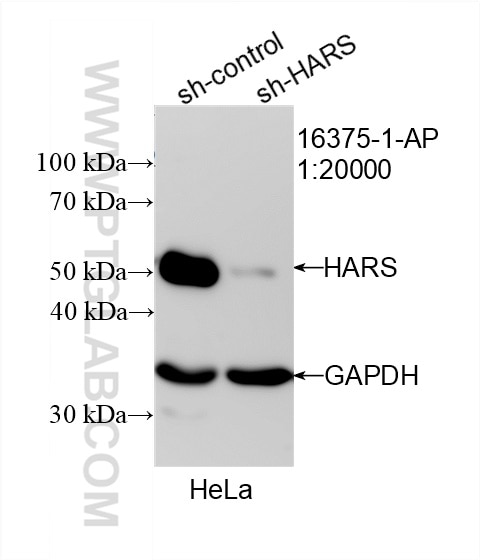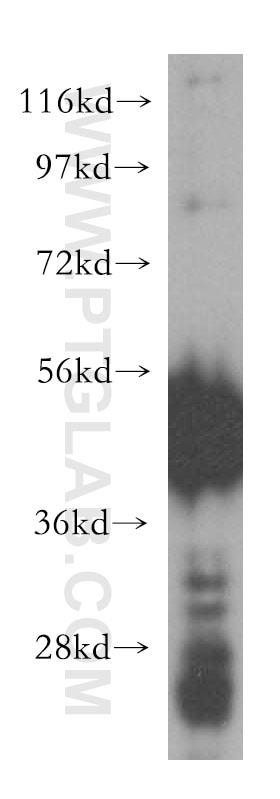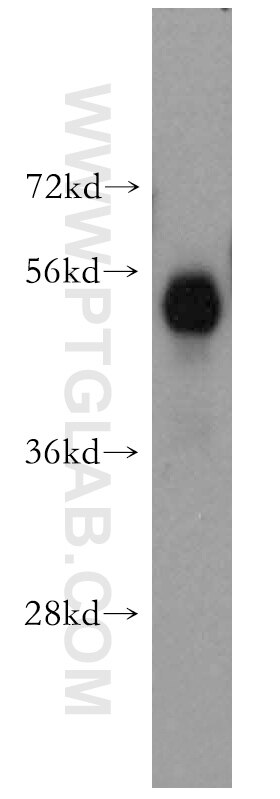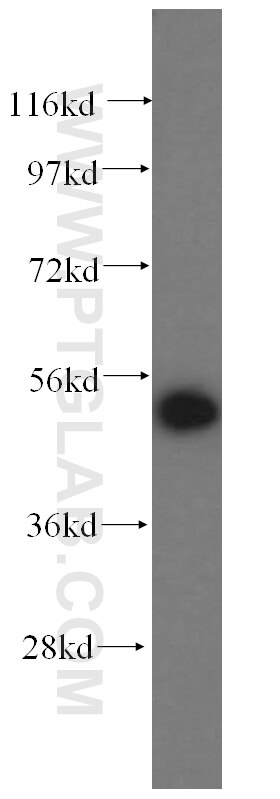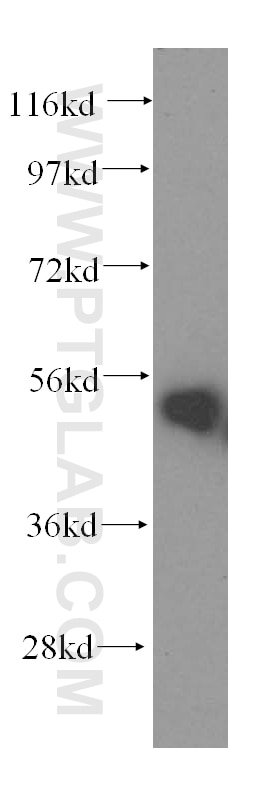- Phare
- Validé par KD/KO
Anticorps Polyclonal de lapin anti-HARS
HARS Polyclonal Antibody for WB, IHC, ELISA
Hôte / Isotype
Lapin / IgG
Réactivité testée
Humain, rat, souris
Applications
WB, IHC, ELISA
Conjugaison
Non conjugué
N° de cat : 16375-1-AP
Synonymes
Galerie de données de validation
Applications testées
| Résultats positifs en WB | tissu hépatique de souris, cellules HeLa, cellules K-562, tissu cardiaque de souris, tissu cérébral de souris, tissu pulmonaire de souris, tissu rénal humain |
| Résultats positifs en IHC | tissu d'estomac humain, il est suggéré de démasquer l'antigène avec un tampon de TE buffer pH 9.0; (*) À défaut, 'le démasquage de l'antigène peut être 'effectué avec un tampon citrate pH 6,0. |
Dilution recommandée
| Application | Dilution |
|---|---|
| Western Blot (WB) | WB : 1:500-1:1000 |
| Immunohistochimie (IHC) | IHC : 1:50-1:500 |
| It is recommended that this reagent should be titrated in each testing system to obtain optimal results. | |
| Sample-dependent, check data in validation data gallery | |
Applications publiées
| WB | See 6 publications below |
Informations sur le produit
16375-1-AP cible HARS dans les applications de WB, IHC, ELISA et montre une réactivité avec des échantillons Humain, rat, souris
| Réactivité | Humain, rat, souris |
| Réactivité citée | Humain, souris |
| Hôte / Isotype | Lapin / IgG |
| Clonalité | Polyclonal |
| Type | Anticorps |
| Immunogène | HARS Protéine recombinante Ag9333 |
| Nom complet | histidyl-tRNA synthetase |
| Masse moléculaire calculée | 509 aa, 57 kDa |
| Poids moléculaire observé | 50 kDa |
| Numéro d’acquisition GenBank | BC011807 |
| Symbole du gène | HARS |
| Identification du gène (NCBI) | 3035 |
| Conjugaison | Non conjugué |
| Forme | Liquide |
| Méthode de purification | Purification par affinité contre l'antigène |
| Tampon de stockage | PBS with 0.02% sodium azide and 50% glycerol |
| Conditions de stockage | Stocker à -20°C. Stable pendant un an après l'expédition. L'aliquotage n'est pas nécessaire pour le stockage à -20oC Les 20ul contiennent 0,1% de BSA. |
Informations générales
HARS is a cytoplasmic enzyme that belongs to the class II family of aminoacyl-tRNA synthetases. The enzyme is responsible for the synthesis of histidyl-transfer RNA, which is essential for the incorporation of histidine into proteins. HARS is located in a head-to-head orientation with HARSL on chromosome five, where the homologous genes share a bidirectional promoter. The gene product is a frequent target of autoantibodies in the human autoimmune disease polymyositis/dermatomyositis. The D364Y (Asp364-to-Tyr) mutation of HARS1 inhibits morphological differentiation of neuronal cells (PMID: 35380399).
Protocole
| Product Specific Protocols | |
|---|---|
| WB protocol for HARS antibody 16375-1-AP | Download protocol |
| IHC protocol for HARS antibody 16375-1-AP | Download protocol |
| Standard Protocols | |
|---|---|
| Click here to view our Standard Protocols |
Publications
| Species | Application | Title |
|---|---|---|
Nat Cell Biol Leucyl-tRNA synthetase is a tumour suppressor in breast cancer and regulates codon-dependent translation dynamics. | ||
Mol Cell A methyltransferase-independent role for METTL1 in tRNA aminoacylation and oncogenic transformation | ||
Sci Rep NRF2 activation ameliorates blood-brain barrier injury after cerebral ischemic stroke by regulating ferroptosis and inflammation | ||
Front Pharmacol S1PR3, as a Core Protein Related to Ischemic Stroke, is Involved in the Regulation of Blood-Brain Barrier Damage. | ||
BMC Med Genomics Analysis of ferroptosis-related genes in cerebral ischemic stroke via immune infiltration and single-cell RNA-sequencing | ||
Neuroscience MyD88 inhibition attenuates cerebral ischemia-reperfusion injury by regulating the inflammatory response and reducing blood-brain barrier damage |

